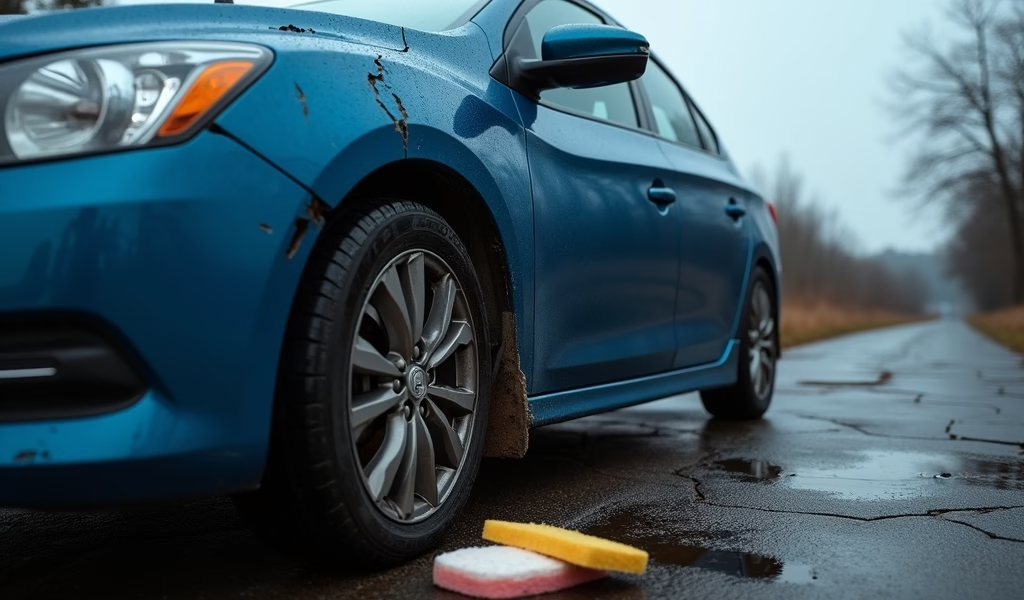Overview
This article presents seven essential auto care strategies that help preserve vehicle performance, appearance, and value, including wax protection, DIY scratch repair, engine maintenance, tire care, interior preservation, fluid monitoring, and seasonal preparation. It emphasizes that becoming a true car lover is about developing a relationship with your automobile through understanding and consistent care, with preventive maintenance always costing less than reactive repairs.
Table of Contents
- Understanding Auto Care: Why It Matters
- Hack #1: Wax Protection Beyond Aesthetics
- Hack #2: DIY Scratch Repair That Actually Works
- Hack #3: Simple Engine Maintenance Anyone Can Master
- Hack #4: Tire Care Secrets for Longevity and Performance
- Hack #5: Interior Care That Preserves Value
- Hack #6: Quick Fluid Checks That Prevent Major Damage
- Hack #7: Seasonal Preparation Strategies
- Conclusion: Becoming a True Car Lover
- Frequently Asked Questions
Understanding Auto Care: Why It Matters
For the dedicated car lover, vehicle maintenance isn’t just a chore—it’s an expression of appreciation for automotive engineering. Whether you’ve just purchased your first vehicle or you’ve been a longtime enthusiast, proper auto care extends your vehicle’s lifespan, maintains its performance, and preserves its value. Think of your car as more than transportation; it’s an investment that deserves attention.
In my 15 years as a mechanic, I’ve seen countless vehicles suffer premature aging simply because owners missed simple maintenance opportunities. The good news? You don’t need advanced technical skills to give your vehicle the care it deserves. These seven proven hacks combine professional wisdom with practical, accessible techniques anyone can master.
The difference between a vehicle that ages gracefully and one that deteriorates quickly often comes down to consistent, informed care. Let’s explore these game-changing approaches that can transform your relationship with your vehicle and save you thousands in unnecessary repairs.
Hack #1: Wax Protection Beyond Aesthetics
Waxing isn’t just about that eye-catching shine car enthusiasts love—it’s functional protection against environmental damage. A quality wax creates an invisible shield between your paint and harmful elements like UV rays, acid rain, tree sap, and road salt. These contaminants can quietly deteriorate your finish long before you notice visual damage.
For maximum protection, aim to wax your vehicle every three months. If this sounds frequent, consider that professional detailers often recommend seasonal application to address changing environmental conditions. The process doesn’t need to be complicated:
- Start with a thoroughly clean, dry surface (washing removes abrasive particles that could scratch during waxing)
- Apply in small sections using circular motions with a microfiber applicator
- Allow to haze slightly before buffing with a clean microfiber cloth
- Test if you’ve finished by sliding your finger across the surface—any squeaking means proper protection
Modern synthetic waxes and ceramic coatings offer even longer-lasting protection, though they come at a premium price point. According to Consumer Reports, high-quality wax application can protect your finish for up to six months when properly applied, making it one of the highest-return investments in your vehicle’s appearance and longevity.
The payoff extends beyond aesthetics—protected paint maintains resale value and prevents costly repainting. Just 30 minutes of waxing every few months can preserve thousands in your car’s value when it’s time to sell or trade.

Hack #2: DIY Scratch Repair That Actually Works
Minor scratches are inevitable, but they don’t require expensive professional repair. For a true car lover, learning to address surface imperfections can be both satisfying and economical. The key is understanding scratch depth and applying the appropriate technique.
First, determine your scratch type by running your fingernail across it. If your nail doesn’t catch, you’re likely dealing with a clear coat scratch—the most manageable type. For these surface-level imperfections:
- Clean the area thoroughly with isopropyl alcohol to remove wax and contaminants
- Apply a small amount of polishing compound using a foam applicator pad
- Work in circular motions with moderate pressure for 30-60 seconds
- Wipe clean and inspect—repeat if necessary
- Seal with wax to protect your restored finish
For deeper scratches that reach the paint or primer layers, touch-up paint becomes necessary. Vehicle-specific paint pens matched to your exact color code (found on your driver’s door jamb sticker) offer the most seamless repairs. Apply in thin layers, allowing proper drying time between coats.
The most important principle is patience. Quality scratch repair isn’t rushed. Working in good lighting and taking your time produces results that often rival professional work at a fraction of the cost. Remember, the goal isn’t perfection but improvement that preserves your vehicle’s appearance and prevents further deterioration from exposed metal.
Hack #3: Simple Engine Maintenance Anyone Can Master
Engine care intimidates many vehicle owners, but several fundamental maintenance tasks require minimal technical knowledge. These simple procedures preserve performance and prevent costly repairs down the road.
Regular oil changes remain the single most important maintenance task for engine longevity. While the old 3,000-mile rule has evolved with modern synthetics, adhering to your manufacturer’s recommended intervals is non-negotiable. Research from Edmunds shows that consistent oil changes can extend engine life by as much as 50% over time.
Air filter inspection takes mere minutes but profoundly impacts performance. A clogged filter forces your engine to work harder, reducing efficiency and power. Check yours by holding it up to a light source—if light doesn’t pass through easily, it’s time for replacement. Most drivers should replace filters annually, but dusty environments may require more frequent changes.
Battery terminal maintenance prevents starting issues with minimal effort. Simply:
- Disconnect cables (always negative first)
- Clean corrosion with a solution of baking soda and water
- Scrub terminals with a wire brush until shiny
- Apply a thin coating of petroleum jelly to prevent future corrosion
- Reconnect cables (positive first, then negative)
For car guy cars that sit occasionally, consider a battery tender to maintain optimal charge. This simple device prevents the deep discharge cycles that shorten battery life, especially in vintage vehicles or seasonal drivers.
Remember, modern engines communicate problems through warning lights for a reason. Ignoring these indicators isn’t frugality—it’s a costly mistake. Address check engine lights promptly, even if performance seems unaffected. Most auto parts stores offer free code reading services that can identify issues before they escalate.
Hack #4: Tire Care Secrets for Longevity and Performance
Tires represent the single most important safety component of your vehicle, yet they often receive minimal attention until problems arise. Proper tire maintenance not only extends their usable life but significantly improves handling, fuel economy, and safety margins.
Pressure monitoring requires just minutes monthly but pays enormous dividends. Underinflated tires flex excessively, generating heat that accelerates wear and reduces fuel efficiency. Overinflated tires provide less contact with the road, compromising traction and comfort. Check pressure when tires are cold (before driving) using a quality gauge—the inexpensive pencil-style gauges provide surprising accuracy.
Rotation schedules matter more than most realize. Front tires typically wear differently than rear tires due to steering forces and weight distribution. By rotating every 5,000-7,000 miles, you ensure even wear across all four tires, maximizing their lifespan. The rotation pattern depends on your vehicle’s drive configuration:
- Front-wheel drive: Front tires move to opposite sides at rear; rear tires move forward on same side
- Rear-wheel drive: Rear tires move to opposite sides at front; front tires move straight back
- All-wheel drive: Cross-rotation pattern (right front to left rear, etc.)
Alignment deserves attention after hitting significant potholes or every two years regardless. Proper alignment ensures even tire wear and optimal handling characteristics. Warning signs include uneven tire wear, steering pull to one side, or a steering wheel that’s off-center when driving straight.
For winter storage, consider reducing pressure slightly and placing vehicles on jack stands to prevent flat-spotting from extended stationary periods. This small step prevents the tire deformation that creates permanent vibrations and premature replacement needs.

Hack #5: Interior Care That Preserves Value
Interior condition often influences resale value more than exterior appearance. A well-maintained cabin suggests overall vehicle care, while neglected interiors raise red flags for potential buyers. Fortunately, interior preservation requires minimal investment.
UV protection represents the most overlooked aspect of interior care. Continuous sun exposure fades dashboards, cracks leather, and deteriorates plastic components. A quality windshield sunshade costs under $20 yet prevents thousands in potential damage. For comprehensive protection, consider applying a UV protectant to dashboard and door surfaces quarterly.
Leather care requires special attention but rewards your effort with longevity. Unlike vinyl, leather needs regular conditioning to prevent drying and cracking. Apply a pH-balanced leather conditioner every 3-4 months, working it gently into seams and high-wear areas. For vehicles with leather interiors, this simple habit preserves the premium feel that justifies their higher resale values.
Vacuum regularly with attention to these often-missed areas:
- Seat tracks where debris accumulates and impedes movement
- Air vents that collect dust and affect climate control effectiveness
- Door pockets and center consoles where small items disappear
- Under seats where items roll during driving
Spill response timing makes all the difference. Keep a small emergency cleaning kit in your vehicle containing microfiber cloths, upholstery cleaner, and stain remover wipes. Addressing spills immediately prevents permanent staining, particularly on fabric seats and carpeting.
For vehicles stored long-term, consider moisture control with desiccant packets or dehumidifiers to prevent the musty odors that develop in humid climates. This small investment prevents the mildew and mold growth that can render interiors unusable and extraordinarily expensive to remediate.
Hack #6: Quick Fluid Checks That Prevent Major Damage
Beyond engine oil, several critical fluids deserve regular attention to prevent catastrophic system failures. These quick checks require minutes but prevent thousands in potential damage.
Transmission fluid condition provides insight into one of your vehicle’s most complex and expensive systems. Check the fluid with the engine running and transmission in park. Fresh fluid appears bright red and translucent—any darkness, burnt smell, or particles indicates potential problems. Unlike engine oil, transmission fluid doesn’t necessarily require regular replacement in many modern vehicles, but its condition should be monitored according to manufacturer guidelines.
Coolant level and condition directly impact engine temperature regulation. Low coolant leads to overheating while deteriorated coolant compromises freeze protection and corrosion resistance. Check the reservoir level when cold and inspect the color—coolant should appear clear in the appropriate color for your vehicle (green, orange, pink, etc.). Cloudy or rusty coolant indicates contamination requiring a complete system flush.
Brake fluid absorbs moisture over time, reducing its effectiveness and potentially damaging internal components. Check the reservoir level monthly and note any darkening of the fluid, which indicates contamination. Most manufacturers recommend replacement every 2-3 years regardless of appearance since moisture absorption isn’t always visible.
Power steering fluid, while often overlooked, prevents expensive steering rack damage. Check with the engine off for accurate levels, and note any frothiness or discoloration that suggests air infiltration or contamination. Many modern vehicles use sealed systems or electric assist, but conventional hydraulic systems require periodic attention.
Washer fluid seems trivial until you’re caught without it in adverse conditions. This inexpensive fluid prevents dangerous visibility limitations during winter driving or after highway debris impacts. In winter climates, ensure you’re using freeze-resistant formula rated for your local temperature extremes.
Hack #7: Seasonal Preparation Strategies
Seasonal transitions demand specific maintenance approaches that preserve your vehicle’s condition through changing environmental challenges. Adapting your care routine to seasonal realities prevents unnecessary wear and ensures reliability when you need it most.
Winter preparation should begin before temperatures drop. Battery capacity diminishes significantly in cold weather—a battery that functions perfectly in summer may fail in winter. Have your battery load-tested in fall to measure its actual capacity. This simple diagnostic predicts failure before you’re stranded in freezing conditions.
Wiper blade inspection becomes critical before winter driving. Blades deteriorate gradually, making decline difficult to notice until visibility is seriously compromised. Replace blades showing any cracking, streaking, or frame exposure. Consider winter-specific blades in snow regions—their reinforced design prevents ice buildup that renders standard blades ineffective.
Summer preparation centers on cooling system integrity. Before hot weather arrives:
- Inspect all coolant hoses for softness, cracking, or bulging
- Check the radiator cap seal for deterioration
- Ensure electric cooling fans activate properly during idle
- Verify air conditioning performance before you need it
Tire transitions between seasons affect more than traction—they impact fuel economy, handling, and safety margins. All-season tires represent a compromise that performs adequately in moderate conditions but sacrifices performance at temperature extremes. True car enthusiasts often maintain separate wheel sets for winter and summer, recognizing that purpose-built tires deliver superior performance in their intended conditions.
Storage preparation for vehicles that hibernate seasonally prevents deterioration during inactivity. Fuel stabilizer prevents gasoline breakdown, full fuel tanks minimize condensation, and battery tenders maintain electrical systems. These simple steps ensure your vehicle awakens from storage ready for immediate use rather than requiring revival.
Conclusion: Becoming a True Car Lover
Becoming a true car lover isn’t about having the most expensive vehicle or the most extensive knowledge—it’s about developing a relationship with your automobile based on understanding and consistent care. The seven hacks we’ve explored represent the foundation of responsible ownership that preserves your vehicle’s performance, appearance, and value.
The most important insight may be that preventive maintenance always costs less than reactive repairs. Small investments of time and attention prevent major expenses later. This principle applies whether you drive a classic collector’s item or a practical daily driver.
Remember that automotive care isn’t just mechanical—it’s emotional. The satisfaction of maintaining something complex and valuable creates connection beyond mere transportation. Your vehicle becomes an extension of your identity and values rather than simply a tool.
As you implement these techniques, you’ll discover that automotive care becomes less a chore and more a rewarding ritual. You’ll notice subtle improvements in performance, appearance, and reliability that validate your efforts. Most importantly, you’ll develop confidence in your vehicle that transforms every journey from ordinary transportation into a genuinely enjoyable experience.
The road to becoming a car lover is paved with these small, consistent actions that demonstrate respect for automotive engineering. Your vehicle will reward your attention with years of reliable service and preserved value—the true hallmarks of successful ownership.
Frequently Asked Questions
What makes someone a true car lover?
A true car lover appreciates automobiles beyond basic transportation, showing dedication through consistent maintenance, interest in automotive history or technology, and pride in their vehicle. The passion manifests as care and attention rather than necessarily owning expensive or rare models.
How often should a car lover detail their vehicle?
Most enthusiasts perform a thorough exterior detail including wash, clay bar treatment, and wax quarterly, with interior detailing at the same intervals. Weekly quick washes and monthly interior cleaning maintain appearance between full detailing sessions.
What’s the best starter car for a budding car lover?
The ideal starter car balances reliability, repair-friendly design, and enjoyable driving dynamics—vehicles like the Mazda Miata, Honda Civic, or Volkswagen Golf GTI fit this profile. Look for models with strong enthusiast communities and widely available parts.
Do car lovers need special insurance?
Enthusiast vehicles often benefit from specialty insurance that offers agreed value coverage rather than depreciation-based valuation. These policies typically offer better protection for modified vehicles and collector cars while sometimes costing less than standard policies.
What’s the most important tool for a car lover to own?
A quality floor jack with jack stands is the foundation of DIY maintenance, allowing safe access for most basic procedures. This single investment enables oil changes, brake work, and tire rotations that form the core of home maintenance.

